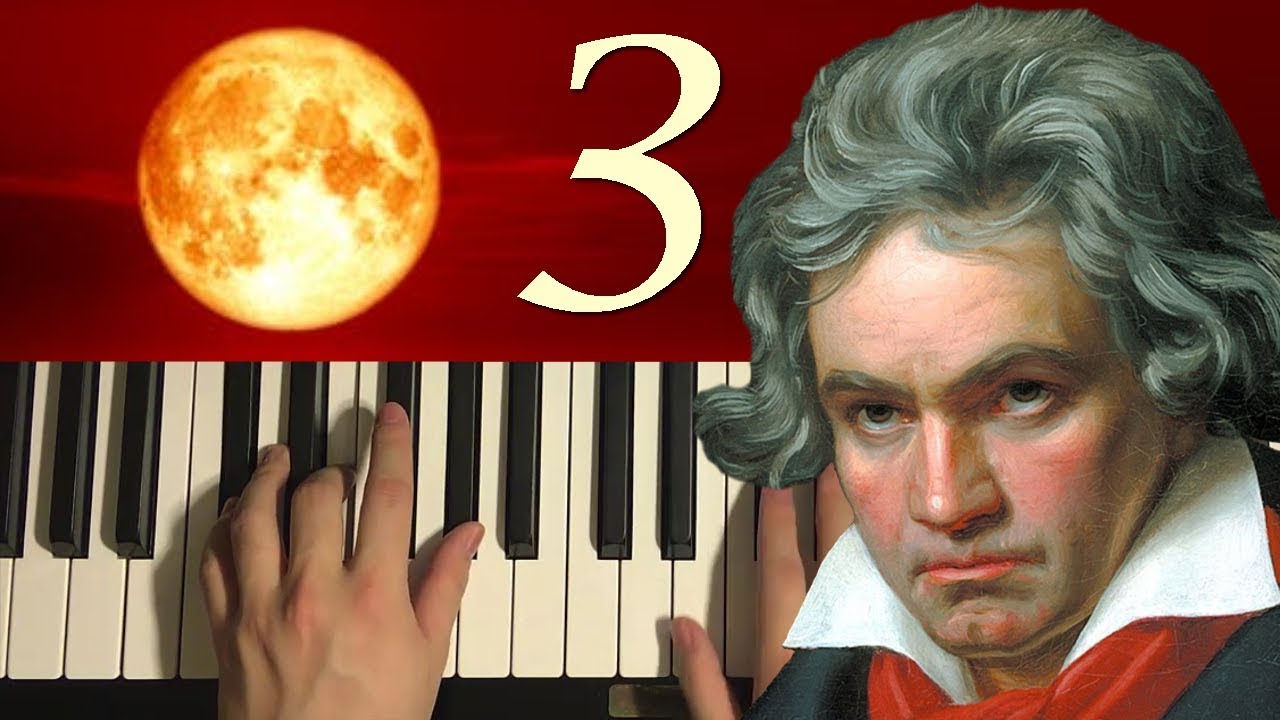Moonlight Sonata is a popular piano piece composed by Ludwig van Beethoven. The third movement, “Adagio cantabile”, is the most well-known and beloved section of the sonata. Many beginners find it quite challenging, but with some practice, it can be played beautifully.
Here are some tips on how to play Moonlight Sonata 3rd movement:
First, take some time to familiarize yourself with the sheet music. Notice the key signature – it’s in C# minor.
This means that there will be sharps (#) on certain notes throughout the piece. Pay attention to the tempo marking – “Adagio cantabile” means that this section should be played slowly and lyrically.
Once you have a feel for the overall piece, begin practicing hands separately.
The left hand plays mostly chords, while the right hand has a melody line. It can be helpful to start by playing just the chords with your left hand, then adding in the melody with your right hand once you’re comfortable. As you practice, make sure to keep a steady tempo and smooth transitions between notes.
With some patience and practice, you’ll be able to play Moonlight Sonata 3rd movement flawlessly!
- Sit at a piano and begin by playing the first note, E, with your right hand
- Play the next note, B, with your left hand
- Continue alternating between hands, playing each note in the melody until you reach the end of the piece

Credit: www.reddit.com
How Do I Play Moonlight Sonata 3Rd Movement
The Moonlight Sonata 3rd Movement is one of the most popular classical pieces ever written, and continues to be a favorite among pianists and music lovers alike. Many people are familiar with the first two movements of the Moonlight Sonata, but the third movement is often overlooked. This article will provide a step-by-step guide on how to play the Moonlight Sonata 3rd Movement.
Before beginning, it is important to note that this piece was originally written for piano solo. However, it can also be played on other instruments such as guitar or violin. The key signature for this piece is C# minor.
Now let’s take a look at the structure of this piece. The Moonlight Sonata 3rd Movement consists of four main sections: an introduction, two main themes (A and B), and a coda. Each section will be explored in more depth below.
The Introduction: The introduction begins with a simple melody in the right hand while the left hand plays chords underneath. This melody is repeated several times before increasing in intensity as it leads into the first theme (Theme A).
Theme A: Theme A is characterized by its fast tempo and staccato (short, detached) notes in the right hand.
The left hand plays broken chords throughout this section. This theme is repeated several times before transitioning into Theme B.
Theme B: Theme B is much slower than Theme A and has a more lyrical quality to it.
In addition to playing broken chords in the left hand, there are also some arpeggios (broken chords played one note at a time). This theme eventually builds up to a climax before fading away into silence.
Coda: The coda brings us back to the original melody from the introduction, but now both hands are playing together creating a fuller sound.
Once You Have the Sheet Music, You Can Begin Practicing the Song
Assuming you already know how to read sheet music, begin by practicing the song slowly. Get comfortable with the melody and chords before speeding up. If you get stuck on a particular section, slow it down or break it into smaller pieces.
Remember to relax and have fun!
Make Sure to Listen to a Recording of the Song So That You Can Get an Idea of How It Should Sound
Assuming you would like a blog post on how to sing the song “Somewhere Over the Rainbow”, here are some tips:
The first thing you need to do is find a recording of the song so that you can get an idea of how it should sound. Once you have found a recording, listen to it carefully and try to mimic the singer’s vocal range and style.
If you can’t find a recording, try looking up a karaoke version of the song so that you can at least hear the melody.
Once you have listened to the recording, it’s time to start practicing. Begin by singing along with the recording, matching your pitch as closely as possible.
As you become more comfortable with the melody, start experimenting with your own interpretation. You may want to add vibrato or trills, for example. Just make sure not to stray too far from the original melody – this is a classic song for a reason!
As you practice, pay attention to your breathing and posture. Proper breath support will help improve your tone and prevent fatigue. And good posture will not only help you project your voice better but also prevent strain on your vocal cords.
Finally, don’t be afraid to show off your unique vocal personality! This is YOUR chance to shine, so make the most of it!
Conclusion
The Moonlight Sonata is one of the most popular piano pieces ever written. The third movement, in particular, is a favorite among pianists. In this post, we’ll show you how to play the third movement of the Moonlight Sonata.
The third movement of the Moonlight Sonata is in A-flat major. It is marked as “Adagio sostenuto” which means “slow and sustained.” The entire movement is played pianissimo (very softly).
The left hand plays a simple melody while the right hand accompanies with arpeggios (broken chords). As you play, pay attention to the dynamics (loudness and softness) and tempo (speed) markings. These are crucial to creating the desired mood for this piece.
With practice, you will be able to play this beautiful piece just like Beethoven intended!
- Test Post 2022-12-09 - February 14, 2024
- How to Run in Pokemmo - February 13, 2024
- How Much is My Lol Account - February 13, 2024

